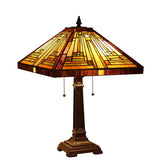Tiffany Lamps: A Comparison of Craftsmanship between the Last Century and Modern Times
Perhaps you stumble upon a Tiffany lamp passed down from the last century in your grandmother's attic, and it could potentially fetch a legacy-worthy $10,000,000 at a Christie's auction. However, such a possibility is exceedingly rare. While artworks like Tiffany lamps can indeed achieve high prices in certain cases, auction values are influenced by various factors, including the lamp's integrity, historical background, the reputation of its designer, and market demand. While Tiffany lamps might fetch high prices in auctions, it's far from a certainty.

Early Years: The Genesis of Louis Comfort Tiffany
The history of Tiffany lamps dates back to the late 19th and early 20th centuries in America. These exquisite handcrafted pieces are renowned for their exquisite glasswork and unique designs.
The creator of Tiffany lamps is Louis Comfort Tiffany. He was born into an artistic family in New York, with his father being the renowned jeweler Charles Tiffany. Nurtured in the realm of art and design, Tiffany began to develop a keen interest in glasswork.
In 1885, he established the Tiffany Studios and embarked on experimenting with various techniques to create colored glass. He developed a glass known as "Favrile," which possessed a unique luster and color. This innovation paved the way for his future designs.
Why are Tiffany lamps so expensive? Let's take a look at how it's made
The process of crafting Tiffany lamps begins with design. Artists create initial designs based on themes, styles, and sizes, often drawing them on paper, including patterns, colors, and details.

The selection of materials is crucial. Different colors, textures, and opacities of glass create various effects within the lamp. Each piece of glass is carefully chosen to ensure color and texture consistency.
Cutting and assembly involve cutting glass into different shapes and sizes. The copper foil technique is used to wrap glass pieces in thin copper foils, allowing the glass pieces to be soldered together. Copper foil is gently bent and shaped to fit the contours of each glass piece.

Soldering securely bonds the glass pieces wrapped in copper foil. Care must be taken with temperature and soldering time to ensure strong connections without damaging the glass.

Coloring and details involve gradual changes in glass colors during the production process. Artists utilize techniques such as painting, oxidation, and acid etching to create subtle color variations and textures. These details enhance the visual complexity of the lamp.

Casting copper is often used for the lamp's base and decorative components. These parts can be cast using techniques that impart intricate shapes and textures.

The assembly process begins once all glass pieces are soldered together, and decorative components are prepared. This involves mounting glass pieces and decorative elements onto the copper structure, ensuring each detail is accurate. Lastly, the lamp is cleaned, polished, and inspected to ensure flawless perfection.
Compared with modern technology
Modern manufacturing technologies grant makers access to a wider range of high-quality glass, aiding in creating richer colors and effects. Additionally, modern Tiffany lamps may utilize more advanced metal alloys such as copper and aluminum to provide better structural stability.

Advancements in modern technology allow for finer and more intricate cutting, melting, and shaping processes. This means that modern Tiffany lamps may feature more delicate details and higher levels of craftsmanship. Modern techniques also utilize computer-aided design (CAD) for more precise designing and crafting processes.

Modern Tiffany lamp designers have the opportunity to blend traditional Tiffany style with contemporary aesthetics, resulting in unique pieces. They can draw inspiration from past designs while incorporating current art and design trends, leading to more diverse and creative creations.
With improved modern manufacturing technology comes better quality control. This implies that modern Tiffany lamps may excel in terms of quality and consistency, avoiding some of the variations that might occur in handcrafted production.

Nevertheless, there are still manufacturers dedicated to traditional craftsmanship, striving to preserve and replicate the style and quality of last-century Tiffany lamps. Ultimately, personal aesthetics and values might differ, with some preferring classic vintage styles and others favoring designs that blend modern innovation.
Summarize
In conclusion, modern craftsmanship in Tiffany lamps boasts many advantages. However, whether it's traditional last-century craftsmanship or contemporary techniques, Tiffany lamps represent the pinnacle of glasswork and artistic creativity.
I am tiffanylampusa, a manufacturer of Tiffany lamps. If you're interested in using Tiffany lamps to decorate your home, feel free to visit my website and place an order: https://tiffanylampusa.com













Leave a comment
Please note, comments need to be approved before they are published.